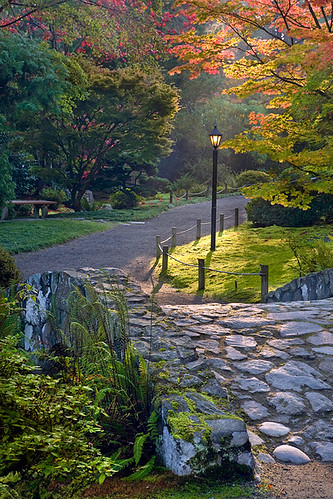by aleks
 |
SJG - 11/14/10, 4:00 PM • We Closed the Garden.
The staff and volunteers will welcome you back in February 2011. |
The last tour of the year is over. The last sitting of Katsura exhibition is done. The garden season of 2010 is finished. A couple from Snohomish (she originally from Texas and a he from England) took the tour, as well as a couple from Seattle and a happy, smiling lady I don't know where from, because she joined us half way through the tour. A very strange feeling to be doing the last tour of the season. If it wasn't for the fact that I was scheduled for Katsura sitting I'd drag it forever to try defy the time and make it last a little while longer.
|
SJG • 11/14/10 - It's getting dark. Lantern reflection in the pond...
|
We all took in the last sights of the colorful autumn garden: the red maples and yellow ginko leaves, the late afternoon light breaking through the clouds and gently caressing the evergreen pines, even the tiny drizzle of rain which which felt like happy tears upon seeing the image of perfection. The last fall haiku in Azumaya read:
trusting its fate
to the autumn wind...
duckweed
Kobayashi Issa, 1808, translated by David Lanou
And what is duckweed? Somebody asked. I don't really know, will check. A plant, or something, which will travel with wind, trusting to be deposited where it needs to be.
We came across Mary Ann C. horsing around like a kid while picking the ginko leaves for drying: it's true, they are like this - pretty and yellow - only shortly this time of the year: 'It'll be good to dry them and show them to people touring in the spring'. Besides, she said, she just wanted to steal the last glances of the Garden before it closes for the rainy season.
 |
| SJG • 11/14/10: Kids: 'Good night, fishes!' |
Many people and children were doing the same: trying to catch the last sight of koi, the last view from the Kobe lantern position's on the top of the mountain hill, the last picture of of the fall leaves. Everybody happy, kind of in a dreamy mood of the 1947 'Goodnight moon' bedtime story by Margaret Wilson Brown: goodnight red maple, goodnight Mr. Yamazaki pine, goodnight bridges and lanterns... Goodnight kingfisher - was it you, making so much noise above the lake tonight? Were you, too, saying goodnight? You can fly over the admission booth tomorrow...
Michele was Katsura- sitting when i breathlessly arrived in the T-room for my photo-sitting shift. No, she and Mary Ann K. wouldn't mind if I went back to take a few last pictures and collect a few ginko leaves myself. So I walked back, and saw a happy young man smiling at the scenery, just breathing and taking it all in. He later stopped by the Katsura exhibition, but it was closing now, too. David is his name, it transpired later, when we chatted in front of the now closed gate, from Boston, presently living in Seattle - hopefully chiming in here soon, so I can tell him about other gardens, open all winter here.
|
SJG • 11/14/10 • 'Is that the tree everybody is talking about?' Yes, ginko 'snow'
|
When I was taking the last pics of ginkos a young couple joined me: she was training her camera lenses on the leaves covering the ground, while he asked: 'Is that the tree everybody is talking about?'. Yes, yes. 'The snow of ginkos on the ground?' That's it.
--------------------
P.S.
Duckweed, or water lentils, the smallest flowering plants, are aquatic plants which float on or just beneath the surface of still or slow-moving fresh water bodies...


 3. Hanamayu uses waste cocoons which are dirty, damaged or have already been used for silk. Though often stained or misshapen, when dyed they display a beautiful variety of shades.
3. Hanamayu uses waste cocoons which are dirty, damaged or have already been used for silk. Though often stained or misshapen, when dyed they display a beautiful variety of shades.  4. A petal shape is cut with the natural curve of the cocoon. Many thin pieces are peeled off of the cocoon.
4. A petal shape is cut with the natural curve of the cocoon. Many thin pieces are peeled off of the cocoon. 







 Two of them actually used it: if you scroll down on the right side to 'Contributors', you will see two names added:
Two of them actually used it: if you scroll down on the right side to 'Contributors', you will see two names added:






